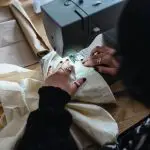Are you curious about the fabric construction of faux leather? Look no further! In this article, we’ll provide you with an in-depth understanding of how faux leather is made.
We’ll break down the composition, explore the inner layers, unveil the bonding process, and examine the role of backing material.
Additionally, we’ll delve into the various finishing techniques used to enhance texture and durability.
Get ready to dive into the fascinating world of faux leather construction!
Table of Contents
Understanding Faux Leather: A Brief Overview
Faux leather, also known as synthetic leather, is a popular alternative to real leather. It is made from a combination of fabric and polyurethane, giving it a similar appearance and texture to genuine leather. Faux leather is often used in the manufacturing of various products, such as furniture, garments, and accessories.
One of the main benefits of faux leather is its affordability. Compared to real leather, faux leather is typically much cheaper, making it a more budget-friendly option for those who want the luxurious look of leather without the high price tag. Additionally, faux leather is more resistant to wear and tear, making it a durable choice that can withstand daily use.
Another benefit of faux leather is its versatility. It can be easily manipulated and molded into different shapes and designs, allowing for a wide range of creative possibilities. Faux leather also comes in various colors and patterns, giving consumers more options to match their personal style.
In terms of maintenance, faux leather is relatively low-maintenance compared to real leather. It is resistant to stains and can be easily cleaned with a damp cloth. Unlike real leather, faux leather does not require special treatments or conditioning.
Overall, faux leather offers an affordable, durable, and versatile alternative to real leather, making it a popular choice for many consumers.
The Composition of Faux Leather: Breaking It Down
Breaking it down, the composition of faux leather involves a combination of synthetic materials. This allows for a more affordable and versatile alternative to genuine leather. Faux leather is typically made from a base fabric, such as polyester or cotton, which is then coated with a layer of polyurethane (PU) or polyvinyl chloride (PVC). Both PU and PVC are types of plastic that provide the leather-like appearance and texture.
The table below provides a breakdown of the composition and material properties of faux leather:
| Component | Material Properties |
|---|---|
| Base Fabric | Polyester or Cotton |
| Coating | Polyurethane (PU) or PVC |
| Appearance | Leather-like texture and sheen |
| Durability | Resistant to abrasion and fading |
| Breathability | Less breathable than genuine leather |
| Maintenance | Easy to clean and maintain |
The base fabric provides the structure and strength of the faux leather, while the coating gives it the desired leather-like appearance. Faux leather has a similar texture and sheen as genuine leather, but it is less breathable. However, it is more durable and resistant to fading and abrasion. Additionally, faux leather is easy to clean and maintain, making it a popular choice for furniture, clothing, and accessories.
Exploring the Inner Layers: Construction of Faux Leather
In this section, we’ll delve into the layered structure of faux leather and explain how it differs from genuine leather.
Understanding the construction of faux leather is crucial in distinguishing it from the real thing. We’ll discuss the various layers involved and provide detailed insights into the key differences between faux and genuine leather.
Layered Structure Explained
The layered structure of faux leather involves the combination of a fabric backing, a polyurethane coating, and a protective finish. This layering process is crucial in creating a material that mimics the look and feel of genuine leather while providing durability and structural integrity.
| Layer | Purpose |
|---|---|
| Fabric backing | Provides a stable base for the coating |
| Polyurethane | Gives the material its leather-like appearance and texture |
| Protective finish | Enhances the durability and resistance to wear and tear |
The fabric backing, typically made of polyester or cotton, serves as the foundation for the faux leather. It provides stability and prevents the material from stretching or sagging over time. The polyurethane coating is applied on top of the fabric backing and gives the faux leather its leather-like appearance and texture. This coating is what gives the material its ability to replicate the natural grain and pattern found in genuine leather. Lastly, the protective finish is applied to enhance the durability and resistance to wear and tear, making the faux leather long-lasting and easy to maintain.
Differentiating Faux From Real
Differentiating between real and faux leather can be challenging for consumers who are not familiar with the construction processes. Both materials can have visual similarities, making it difficult to determine which one is authentic. However, there are several key factors to consider when trying to differentiate between the two:
-
Texture: Real leather has a unique grain pattern and texture that is difficult to replicate. Faux leather, on the other hand, often has a more uniform texture.
-
Smell: Real leather has a distinct, natural smell, while faux leather may have a chemical or synthetic odor.
-
Price: Real leather is generally more expensive than faux leather. So if a product is priced significantly lower than what you would expect for real leather, it’s likely faux.
Unveiling the Bonding Process: How Faux Leather Is Assembled
To understand how faux leather is assembled, let’s take a closer look at the bonding process. Faux leather is created using various bonding techniques and fabrication methods.
One common method is known as the polyurethane (PU) bonding technique. This involves applying a layer of polyurethane to a fabric base, which is typically made of polyester or cotton. The polyurethane is then treated to create a textured surface that mimics the look and feel of genuine leather.
Another bonding technique used in faux leather fabrication is the thermoplastic bonding method. This involves using heat and pressure to fuse together two or more layers of fabric, with a layer of thermoplastic polyurethane (TPU) film in between. The TPU film acts as a binder, creating a strong bond between the layers of fabric.
In addition to these bonding techniques, other fabrication methods are employed to enhance the durability and appearance of faux leather. These methods may include embossing, printing, and coating.
Embossing involves imprinting a pattern onto the surface of the faux leather, giving it a textured appearance. Printing allows for the application of various designs and patterns onto the faux leather. Coating involves adding a protective layer to the surface of the faux leather, enhancing its resistance to wear and tear.
Overall, the bonding process plays a crucial role in the construction of faux leather, ensuring its strength and durability while creating a realistic leather-like appearance.
The Role of Backing Material: Enhancing Faux Leather’s Structure
Enhancing the structure of faux leather, backing material provides support and stability to the layers of fabric. This crucial component plays a significant role in ensuring the structural integrity of faux leather products.
Here’s what you need to know about the role of backing material in enhancing faux leather’s structure:
-
Reinforcement: The backing material reinforces the layers of fabric, preventing them from tearing or stretching excessively. It adds strength and durability to the faux leather, making it more resistant to wear and tear.
-
Smoothness: The backing material helps to create a smooth and even surface on the backside of faux leather. This not only enhances the aesthetic appeal but also improves the overall feel and comfort of the material.
-
Dimensional stability: By providing support, the backing material helps faux leather maintain its shape and form. It prevents the material from sagging or deforming over time, ensuring that the product retains its original appearance for longer.
Examining Finishing Techniques: Adding Texture and Durability
Adding texture and durability, finishing techniques play a crucial role in enhancing the overall quality of faux leather products. These techniques involve various processes that contribute to the final appearance and performance of the material.
One common finishing technique is embossing, which creates a textured surface on the faux leather. This not only adds visual interest but also enhances the tactile experience of the product. By imprinting patterns or designs onto the fabric, embossing can give the faux leather a more realistic look and feel.
Another finishing technique is coating, where a protective layer is applied to the surface of the material. This coating not only adds durability but also helps to improve resistance to abrasion and staining. Additionally, the coating can provide a glossy or matte finish, depending on the desired aesthetic.
Other finishing techniques include buffing, where the surface is smoothed to remove imperfections, and printing, where patterns or designs are directly printed onto the faux leather. All of these techniques work together to add texture and enhance durability, making faux leather products more visually appealing and long-lasting.
Conclusion
In conclusion, faux leather is a popular alternative to real leather due to its affordability and versatility. It is made by bonding a fabric backing material with a polyurethane or PVC coating.
The construction of faux leather involves multiple layers, including a base fabric, a foam layer, and a top coating. The bonding process ensures that these layers are securely attached, creating a durable and long-lasting material.
Additionally, finishing techniques are applied to add texture and enhance the overall appearance of faux leather.
Overall, understanding the fabric construction of faux leather provides insight into its unique properties and widespread use in various industries.
- How Does Ring Spun Cotton Affect Garment Fit and Shape Retention? - August 13, 2024
- What Are the Challenges in Producing Ring Spun Cotton? - August 13, 2024
- Is Ring Spun Cotton Suitable for Plus-Size Clothing? - August 13, 2024




